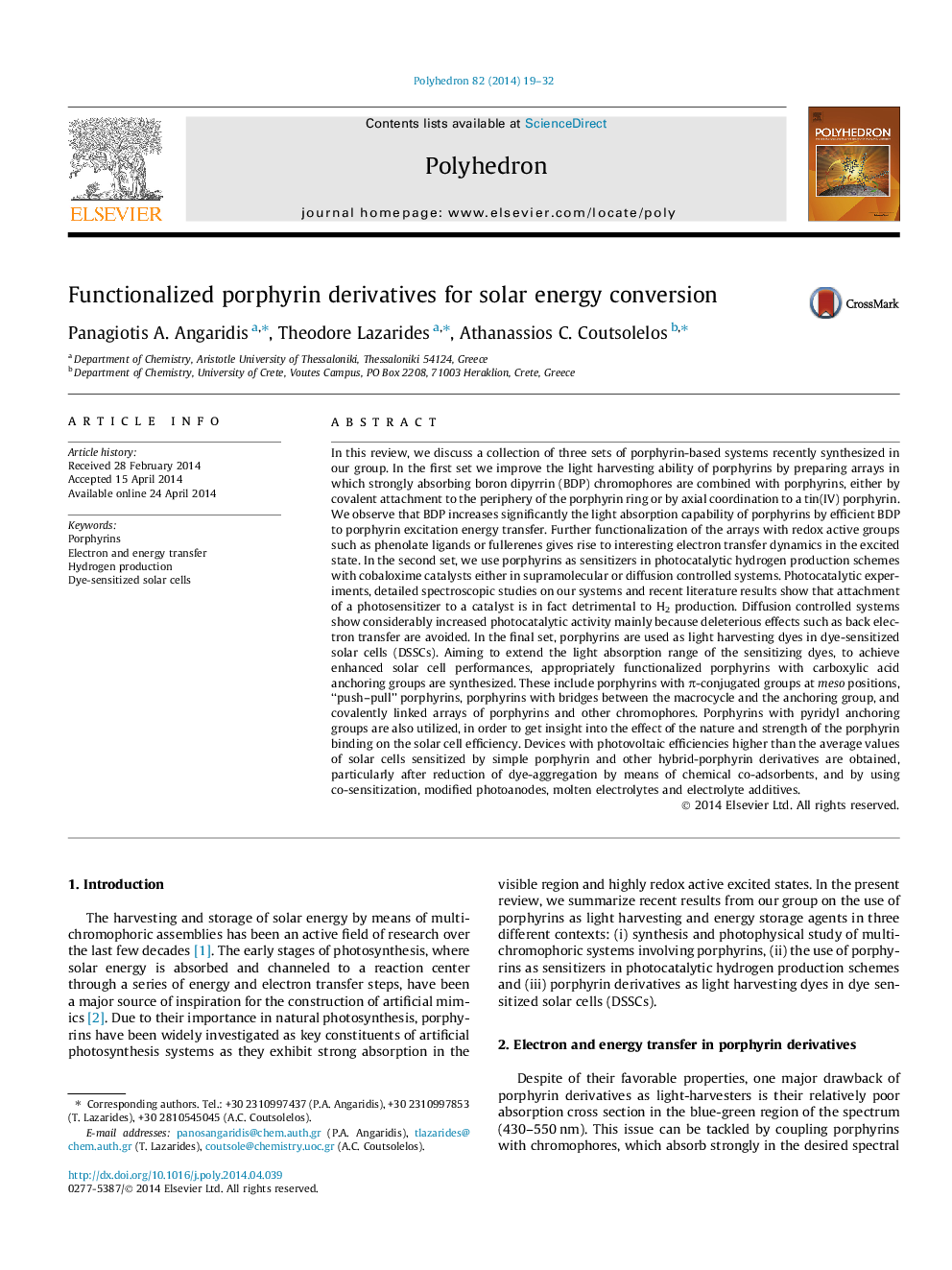| Article ID | Journal | Published Year | Pages | File Type |
|---|---|---|---|---|
| 1336435 | Polyhedron | 2014 | 14 Pages |
In this review, we discuss a collection of three sets of porphyrin-based systems recently synthesized in our group. In the first set we improve the light harvesting ability of porphyrins by preparing arrays in which strongly absorbing boron dipyrrin (BDP) chromophores are combined with porphyrins, either by covalent attachment to the periphery of the porphyrin ring or by axial coordination to a tin(IV) porphyrin. We observe that BDP increases significantly the light absorption capability of porphyrins by efficient BDP to porphyrin excitation energy transfer. Further functionalization of the arrays with redox active groups such as phenolate ligands or fullerenes gives rise to interesting electron transfer dynamics in the excited state. In the second set, we use porphyrins as sensitizers in photocatalytic hydrogen production schemes with cobaloxime catalysts either in supramolecular or diffusion controlled systems. Photocatalytic experiments, detailed spectroscopic studies on our systems and recent literature results show that attachment of a photosensitizer to a catalyst is in fact detrimental to H2 production. Diffusion controlled systems show considerably increased photocatalytic activity mainly because deleterious effects such as back electron transfer are avoided. In the final set, porphyrins are used as light harvesting dyes in dye-sensitized solar cells (DSSCs). Aiming to extend the light absorption range of the sensitizing dyes, to achieve enhanced solar cell performances, appropriately functionalized porphyrins with carboxylic acid anchoring groups are synthesized. These include porphyrins with π-conjugated groups at meso positions, “push–pull” porphyrins, porphyrins with bridges between the macrocycle and the anchoring group, and covalently linked arrays of porphyrins and other chromophores. Porphyrins with pyridyl anchoring groups are also utilized, in order to get insight into the effect of the nature and strength of the porphyrin binding on the solar cell efficiency. Devices with photovoltaic efficiencies higher than the average values of solar cells sensitized by simple porphyrin and other hybrid-porphyrin derivatives are obtained, particularly after reduction of dye-aggregation by means of chemical co-adsorbents, and by using co-sensitization, modified photoanodes, molten electrolytes and electrolyte additives.
Graphical abstractIn this review, we report the collection of three sets of porphyrin-based systems recently synthesized in our group. In the first set we improve the light harvesting ability of porphyrins by preparing arrays in which strongly absorbing boron dipyrrin (BDP) chromophores are combined with porphyrins, either by covalent attachment to the periphery of the porphyrin ring or by axial coordination to a tin(IV) porphyrin. In the second set, we use porphyrins as sensitizers in photocatalytic hydrogen production schemes with cobaloxime catalysts either in supramolecular or diffusion controlled systems. In the final set, porphyrins are used as light harvesting dyes in dye-sensitized solar cells (DSSCs).Figure optionsDownload full-size imageDownload as PowerPoint slide
